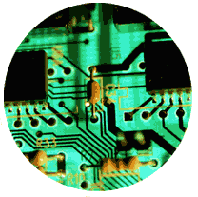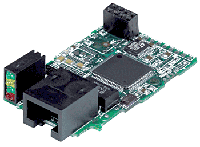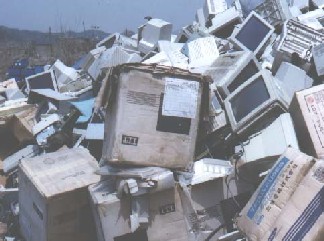| RoHS & WEEE
The bigger picture
for business...
In
our second feature on the RoHS DIrective, Gary
Nevison, Head of Product and Market Strategy, Premier
Farnell Europe and Asia Pacific, reflects on the
wider business implications of the upcoming RoHS
and WEEE legislations.
By now, most in the electronics industry
know what the RoHS (restriction of use of certain
hazardous substances) and WEEE (waste electrical
and electronic equipment) Directives are about. Although
many manufacturers may still be some way from achieving
the compliance demanded by the legislation, they
are only too aware of the deadlines hanging like
dark clouds on the horizon.
While
so much attention has been paid to dealing with the
finite details of the directives, the wider business
implications have been given little consideration – for
example, what are implications of not complying with
RoHS and WEEE?
RoHS Directive
ERA Technology has been awarded a contract by the Department
of Trade and Industry (DTI) to investigate the ways
in which manufacturers can demonstrate compliance
with the requirements of the RoHS Directive. The
project is being funded by the DTI on behalf of the
EC Technical Adaptation Committee (TAC), which is
involved with the implementation of the RoHS Directive
throughout the European Union (EU).
Topics under review include: how to demonstrate compliance;
minimum requirements that protect the environment;
standards of compliance; self declaration; reporting
formats for materials declarations; an information
exchange between producers and enforcement authorities
in EU states. protect the environment;
standards of compliance; self declaration; reporting
formats for materials declarations; an information
exchange between producers and enforcement authorities
in EU states.
Options
for these include relying on information from component
manufacturers, carrying out spot checks or simply
analysing everything. There are, of course, problems
to overcome with any of these options, such as verifying
the accuracy of supplier information, counterfeit
components, the ‘grey’ market,
assessing how many spot checks would be needed and
how they would be implemented. Ultimately, to analyse
everything would be prohibitively expensive, so decisions
about which path will be taken need to be made early
on or progress will be slow.
The project may start with products sold in millions
rather then tens or hundreds, as the former has a much
larger impact on the environment. At the end of the
day, this is the main aim of the directives.
The Directive requires member states to enforce RoHS
but does not, at this stage, clarify how a product
can be deemed to comply. Working with the DTI, ERA
will produce an independent assessment of the issues
involved in demonstrating compliance, from self-declaration
through to appropriate methods of material analysis.
 Although
a wide range of electronic equipment is affected – from
IT and telecoms to electrical tools, household appliances
and medical devices – the main focus is on consumer
electrical equipment. Producers of electronic equipment
carry primary responsibility. Those manufacturing or
reselling under their own brand, or importing/exporting
into a member state are currently defined as ‘producers’.
Any distributor of electronic equipment will have take-back
obligations if they are judged to be a producer. Although
a wide range of electronic equipment is affected – from
IT and telecoms to electrical tools, household appliances
and medical devices – the main focus is on consumer
electrical equipment. Producers of electronic equipment
carry primary responsibility. Those manufacturing or
reselling under their own brand, or importing/exporting
into a member state are currently defined as ‘producers’.
Any distributor of electronic equipment will have take-back
obligations if they are judged to be a producer.
The
UK government is committed to ensuring that implementation
of the RoHS Directive is both effective and workable,
and it is in everyone's interest that a common approach
to assessing RoHS compliance is adopted across the
EU. The project that ERA is undertaking marks an
essential step forward in defining how best to do
this, although it begs the question of whether it
should have happened earlier – thereby
avoiding the confusion with which the industry is
currently battling.
WEEE directive
In respect of the WEEE Directive, it is the producers
which are responsible for products at the end of
their life and must make provision to finance end-of-life
costs, arrange for collection, treatment and recycling.
The fundamental issue here, however, is which party
should be considered the ‘producer’?
How far back down the supply chain does one go before
apportioning responsibility for a product’s
contents? This will need clear definition by national
legislation, in order to ensure responsibility is
taken for driving the programme forward.
Currently,
according to the WEEE Directive, a ‘producer’ is
defined as the party which manufactures and sells equipment
under its own brand, or resells under its own brand
equipment made by another, and imports/exports into
an EU member state on a professional basis. Naturally,
the definition of a producer should be the same in
all EU states – a company can’t be both
importer and exporter.
The
UK Government’s proposed definitions (which
are not finalised) currently suggest that a EU ‘manufacturer’ in
one state may be defined in other states as a ‘producer’.
For example, if a product is made in UK but sold in
France then the UK manufacturer is the producer. For
equipment manufactured outside of the member states,
it is the company or individual which imports it into
the EU which is likely to be regarded the producer – i.e.
equipment imported into the UK from a non-member state
and then sold in France would be considered the UK’s
produce. Interestingly, the focus in these definitions
appears to be on the producer of ‘equipment’ as
opposed to ‘components’ – but then
again there is not yet a firm definition of ‘equipment’…
 Once
identified, the ‘producer’ will
need to lay out a strategy for collection, treatment
and recycling of goods, which could be done individually
or in collective schemes. There are no existing group
collaborations for this in the UK yet (although they
are now being set up for vending machines, large white
goods and possibly retailers). Models do, however,
already exist in other European countries such as Holland,
Belgium, Norway, Sweden and Switzerland. Once
identified, the ‘producer’ will
need to lay out a strategy for collection, treatment
and recycling of goods, which could be done individually
or in collective schemes. There are no existing group
collaborations for this in the UK yet (although they
are now being set up for vending machines, large white
goods and possibly retailers). Models do, however,
already exist in other European countries such as Holland,
Belgium, Norway, Sweden and Switzerland.
Producers
must also finance collection, treatment and recycling
of waste equipment ‘put onto the
market’ and historical waste (non-compliant products
sold before 13th August 2005 but reaching end-of-life
after this date) from 13th August 2005.
Household waste affected by WEEE will probably be
treated by national collection schemes and financed
by existing producers. Business waste will be different,
however. When selling a new piece of equipment, producers
will be obliged to take back an equivalent piece of
equipment fulfilling the same function.
Collection, treatment and recycling will be a net
cost for most products. Collective schemes will benefit
from economies of scale, whilst individual recycling
schemes will offer more opportunities for cost reduction
by better design of goods for recycling. However, collection
costs could be significant for low value products
Unfortunately, both for the environment and because
it would have laid some groundwork for the directives,
there is currently little recycling of electronic waste
in the UK. Moreover, recyclers usually charge for this
service, while the current processes may not be able
meet WEEE targets. Reuse is a lower cost option than
recycling, but is difficult to manage efficiently.
PCs, for example, need to be less than four years old
to qualify for recycling and keeping track of the age
of equipment could incur further costs.
Additional
end-of-life costs are likely to result in increased
prices – by how much is still hard
to guess, but they could be minimised. The main factors
tend to be labour and transport costs. Innovative design
can reduce recycling costs and so minimise impact on
prices – as long as these products are collected
separately at end-of-life. Collaboration too, between
producers, dealers and users, should help minimise
increases through economies of scale. The cost of national
recycling schemes already in operation in other European
countries, has become part of the selling price for
some products. A television, for example, could cost
between 8 and 26 Euros to recycle.
Who will take charge?
The enforcing authorities for all of this have still
to be decided.
For RoHS, it may involve the use of
trading standards departments, although this is by
no means certain. For WEEE, the use of environment
agencies or perhaps the creation of a clearing house.
Penalties, too, have still not been defined but again
we can speculate that for RoHS, they would involve
the removal of offending products from the market,
with fines and/or imprisonment as the ultimate punishment
for non-compliance, and additional personal liability
for directors and senior officers possible.
Responses
to the second Government consultation paper were
due by 1st March 2004, with UK regulations expected
to come into force over the summer or in the early
autumn. No equipment containing any of the banned
substances will be placed on the EU market after
1st July 2006. The UK’s own
recovery and recycling targets are set to be achieved
by 31st December 2006.
The
RoHS and WEEE Directives are far-reaching and environmentally
significant pieces of legislation affecting manufacturers,
importers, resellers and distributors throughout
the electronics industry – the
key to being successful in reaching compliance lies
in all parties working together and maintaining open
channels of communication. |